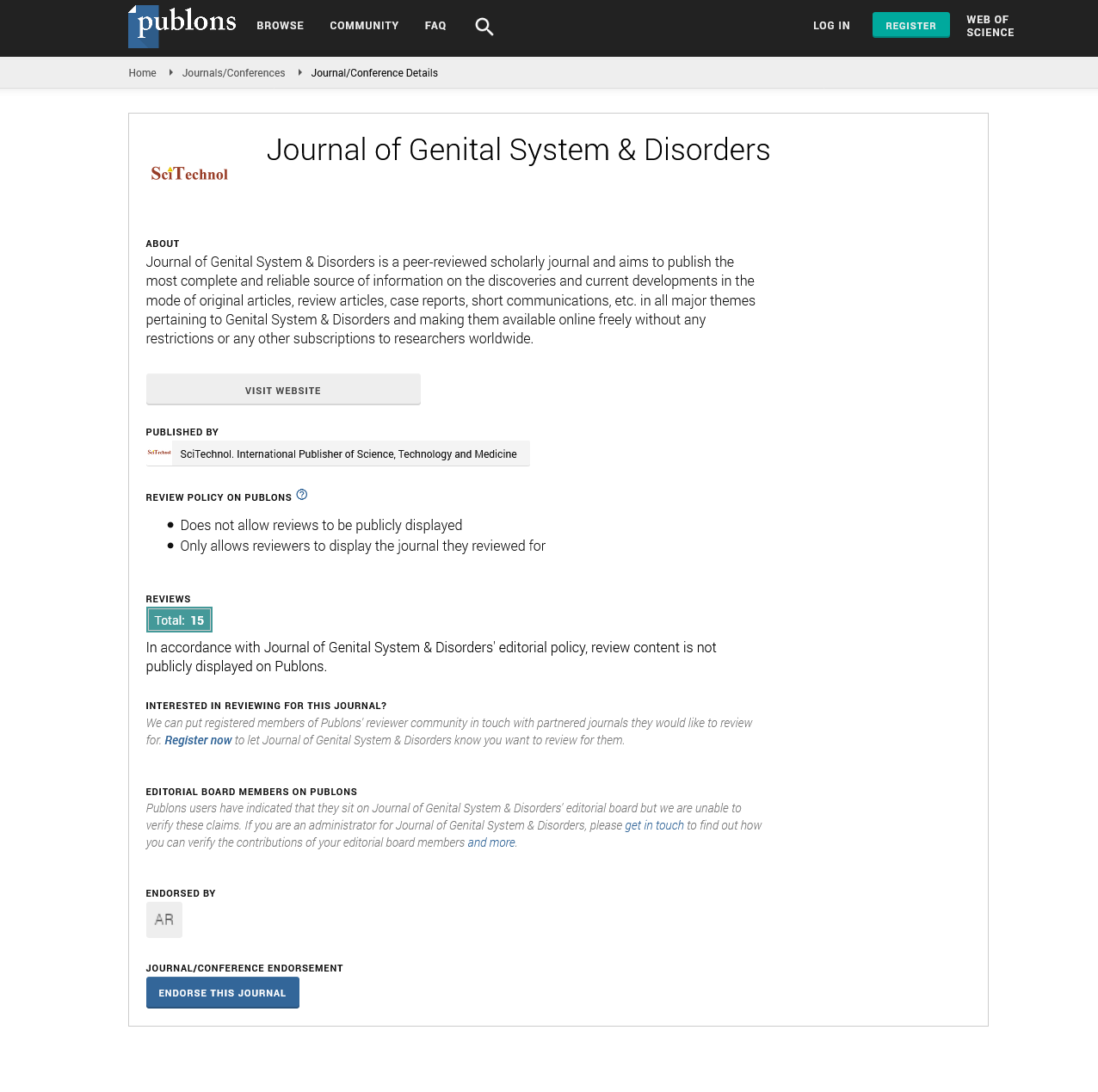Short Communication, J Genit Syst Disord Vol: 12 Issue: 1
Causes, Types, and Treatment of Congenital Anomalies
Melissa Karlan*
Department of Gynecology, University Hospital of Freiburg, Freiburg, Germany
*Corresponding Author: Melissa Karlan
Melissa Karlan, Department of Gynecology, University
Hospital of Freiburg, Freiburg, Germany;
E-mail: karlanmelissa@gmail.com
Received date: 22 February, 2023, Manuscript No. JGSD-23-93538;
Editor assigned date: 24 February, 2023, Pre QC No. JGSD-23-93538 (PQ);
Reviewed date: 10 March, 2023, QC No. JGSD-23-93538;
Revised date: 17 March, 2023, Manuscript No. JGSD-23-93538 (R);
Published date: 24 March, 2023, DOI: 10.4172/ 2325-9728.1000268
Citation: Karlan M (2023) Causes, Types, and Treatment of Congenital Anomalies. J Genit Syst Disord 12:1.
Description
Congenital anomalies, also known as birth defects, are structural or functional abnormalities that occur during fetal development. These anomalies can affect any part of the body and can lead to significant physical, emotional, and cognitive disabilities [1]. The result of abnormal organogenesis in utero is congenital abnormalities. Diaphragmatic hernia, flaws in the abdominal wall, esophageal atresia, spinal bifida, and heart problems are a few of the most typical congenital anomalies seen in newborn intensive care units [2]. It may occur sudden that these birth abnormalities contribute significantly to paediatric disease and account for a considerable part of newborn hospitalisation days globally. The long-term prognosis for affected children has significantly improved over the past 50 years and the technology available for their treatment, such as mechanical ventilator support, extracorporeal membrane oxygenation, and complicated surgical repair [3]. Nonetheless, many of these patients might still experience significant mortality and morbidity, and in some nations, termination rates of up to 25% are not unusual.
Causes
Congenital anomalies can be caused by genetic, environmental, or a combination of both factors. Genetic factors include mutations, chromosomal abnormalities, and inherited traits. Environmental factors include maternal infections, exposure to toxins or drugs during pregnancy, and poor nutrition [4]. In some cases, the cause of a congenital anomaly may not be known.
Types
Congenital anomalies can be classified into several categories based on their anatomical location, severity, and etiology. Some of the common types of congenital anomalies are:
Structural anomalies: These anomalies involve the formation, size, and shape of organs or body parts. Examples include cleft lip and palate, clubfoot, and heart defects [5].
Functional anomalies: These anomalies affect the function of organs or body systems. Examples include hearing loss, vision impairment, and intellectual disability [6].
Metabolic anomalies: These anomalies affect the body's metabolic processes and can result in metabolic disorders such as Phenylketonuria (PKU) or galactosemia.
Developmental anomalies: These anomalies occur due to abnormal embryonic development and can lead to malformations such as spina bifida, anencephaly, and hydrocephalus [7].
Diagnosis
Diagnosing congenital anomalies can be challenging and requires a multidisciplinary approach. Prenatal screening tests such as ultrasound, amniocentesis, and chorionic villus sampling can detect some anomalies before birth [8]. Postnatal diagnosis can be done through physical examination, imaging studies, genetic testing, and other laboratory tests.
Treatment
The treatment options for congenital anomalies depend on the type and severity of the anomaly. Some anomalies may not require treatment, while others may require surgical intervention, medication, or other therapies [9]. Early intervention and management can improve the outcome and quality of life for individuals with congenital anomalies.
Surgery: Surgical intervention is often required for structural anomalies such as cleft lip and palate, heart defects, and clubfoot. Advances in surgical techniques and technologies have improved the outcomes of these procedures.
Medication: Some congenital anomalies can be managed with medication, such as congenital hypothyroidism and congenital adrenal hyperplasia. These medications replace or supplement the hormones that are deficient in the body.
Therapy: Therapy such as physical therapy, occupational therapy, and speech therapy can help individuals with functional anomalies such as cerebral palsy, hearing loss, and intellectual disability. These therapies aim to improve the individual's ability to perform daily activities and enhance their quality of life.
Congenital anomalies are a significant public health issue, affecting millions of individuals worldwide. Understanding the causes, types, and treatment options for congenital anomalies is crucial for healthcare providers, researchers, and policymakers [10]. Early diagnosis, intervention, and management can improve the outcome and quality of life for individuals with congenital anomalies.
References
- Victor BP (2002) Preventing congenital anomalies in developing countries. Community Genet 5: 61-69.
[Crossref] [Google Scholar] [Indexed]
- Naeimeh T, Katayon Y, Nazila N (2010) The Prevalence of congenital malformations and its correlation with consanguineous marriages. Oman Med J 25: 37-40.
[Crossref] [Google Scholar] [Indexed]
- Godwin KA, Sibbald B, Bedard T, Kuzeljevic B, Lowry RB, et al. (2008) Change in frequency of select congenital anomalies since the onset of folic acid fortifications in Canadian birth defect registry. Can J Public Health 99: 271-275.
[Crossref] [Google Scholar] [Indexed]
- Shaw GM, Quach T, Nelso V, Carmichae SL, Schaffer DM, et al. (2003) Neural tube defects associated with maternal periconceptional dietary intake of simple sugars and glycemic index. Am J Clin Nutr 78: 972–978.
[Crossref] [Google Scholar] [Indexed]
- Neumann PE, Frankel WN, Letts VA, Coffin JM, Copp AJ, et al (1994). Multifactorial inheritance of neural tube defects: Localization of the major gene and recognition of modifiers in ct mutant mice. Nat Genet 6: 357-362.
[Crossref] [Google Scholar] [Indexed]
- Graham TP, Driscoll CDJ, Gersony WM, Newburger JW, et al. (2005) Task Force 2: Congenital heart disease. J Am Coll Cardiol 45: 1326-1333.
[Crossref] [Google Scholar] [Indexed]
- Mekonnen GA, Hordof AG, Kitila TT, Adem S (2020) Modifiable risk factors of congenital malformations in bale zone hospitals, southeast Ethiopia: an unmatched case-control study. BMC Pregnancy and Childbirth 20: 129
[Crossref] [Google Scholar] [Indexed]
- Taye M, Afework M, Fantaye W, Diro E, Worku A (2018) Factors associated with congenital anomalies in Addis Ababa and the Amhara region, Ethiopia: A case-control study. BMC Pediatr 18: 142.
[Crossref] [Google Scholar] [Indexed]
- Alverson CJ, Strickland MJ, Gilboa SM, Correa A. (2011) Maternal smoking and congenital heart defects in the Baltimore-Washington infant study. Pediatrics 127: 647-653.
[Crossref] [Google Scholar] [Indexed]
- Little J, Arslan MT, Mossey PA (2004) Smoking and orofacial clefts. A United Kingdom–based case-control study. Cleft Palate Craniofac J 41: 383-386.
[Crossref] [Google Scholar] [Indexed]
 Spanish
Spanish  Chinese
Chinese  Russian
Russian  German
German  French
French  Japanese
Japanese  Portuguese
Portuguese  Hindi
Hindi 
